History of Buddhism
The History of Buddhism spans the 6th century BCE to the present, starting with the birth of Buddha Siddhartha Gautama on the Indian subcontinent, in Lumbini, Nepal.
This makes it one of the oldest religions practiced today. The religion
evolved as it spread from the northeastern region of the Indian
subcontinent through Central, East, and Southeast Asia.
At one time or another, it influenced most of the Asian continent. The
history of Buddhism is also characterized by the development of numerous
movements, schisms, and schools, among them the Theravda, Mahyna and Vajrayna traditions, with contrasting periods of expansion and retreat.
Siddhartha Gautama
Main article: Siddhartha Gautama

The Aoka Chakra, an ancient Indian depiction of the Dharmachakra and depicted on the national flag of India.
Siddhrtha Gautama was the historical founder of Buddhism. He was born a Kshatriya warrior prince in Lumbini, Nepal. The dates of his birth and death are still a point of controversy[1] but most scholars "suggested that the Buddha died within approximately a few decades on either side of 400 B.C.E".[2] His particular family of Sakya Kshatriyas were of Brahmin lineage (Sanskrit: gotra),
as indicated by the family name "Gautama". 19th-century scholars, such
as Dr. Eitel, connected it to the Brahmin Rishi Gautama.[3] In many Buddhist texts, Buddha is said to be a descendant of the Brahmin Sage Angirasa.[4] For example, "In
the Pli Mahavagga "Angirasa" (in Pli Angirasa) occurs as a name of
Buddha Gautama who evidently belonged to the Angirasa tribe...".[5] Scholar Edward J. Thomas too connected Buddha with sages Gautama and Angirasa.[6]
After asceticism and meditation, Siddhartha Gautama discovered the Buddhist Middle Way"a path of moderation away from the extremes of self-indulgence and self-mortification.
Siddhartha Gautama attained enlightenment sitting under a peepal tree, now known as the Bodhi tree in Bodh Gaya, India. Gautama, from then on, was known as "The Enlightened One ," the Samyaksambuddha.
Buddha found patronage in the ruler of Magadha, emperor Bimbisra. The emperor accepted Buddhism as his personal faith and allowed the establishment of many Buddhist vihras. This eventually led to the renaming of the entire region as Bihr.[7]
At the Deer Park near Vras in northern India, Buddha set in motion Wheel of Dharma
by delivering his first sermon to a group of five companions with whom
he had previously sought enlightenment. Together with the Buddha they
formed the first Sagha, the company of Buddhist monks, and hence, the first formation of the Triple Gem (Buddha, Dharma and Sagha) was completed.
For the remaining years of his life, the Buddha is said to have traveled in the Gangetic Plain of Northeastern India and other regions.
Buddha attained parinirva in the abandoned jungles of Kuinra.
Just before Buddha died, he reportedly told his followers that
thereafter the Dharma (doctrine, teaching) would be their leader. The
early arhants considered Gautama's words the primary source of Dharma
and Vinaya (rules of discipline and community living), and took great
pains to formulate and transmit his teachings accurately. Nonetheless,
no ungarnished collection of his sayings has survived. The versions of
the canon (accepted scripture) preserved in Pli, Sanskrit, Chinese, and Tibetan are sectarian variants of a corpus that grew and crystallized during three centuries of oral transmission.[8]
Early Buddhism
Further information: History of Buddhism in India
Early Buddhism remained centered around the Ganges valley, spreading
gradually from its ancient heartland. The canonical sources record two
councils, where the monastic Sangha established the textual collections
based on the Buddha's teachings and settled certain disciplinary
problems within the community.
1st Buddhist council (5th century BC)
Main article: First Buddhist Council
The first Buddhist council was held just after Buddha's Parinirvana, and presided over by Gupta Mahkyapa, one of His most senior disciples, at Rjagha (today's Rajgir)
during the 5th century under the noble support of king Ajthaatru. The
objective of the council was to record all of Buddha's teachings into
the doctrinal teachings (sutra) and Abhidhamma and to codify the monastic rules (Vinaya). nanda,
one of the Buddha's main disciples and his cousin, was called upon to
recite the discourses and Abhidhamma of the Buddha, and Upali, another
disciple, recited the rules of the Vinaya. These became the basis of the Tripiaka (Three Baskets), which is preserved only in Pli.
2nd Buddhist council (4th century BC)
Main article: The Second Buddhist Council
The second Buddhist council was held at Vaisali following a dispute
that had arisen in the Sagha over a relaxation by some monks of various
points of discipline. Eventually it was decided to hold a second
council at which the original Vinaya texts that had been preserved at
the first Council were cited to show that these relaxations went against
the recorded teachings of the Buddha.
Aokan proselytism (c. 261 BC)
Further information: Ashoka the Great and Maurya Empire
See also: Edicts of Ashoka and Ashokavadana
The Maurya Empire under Emperor Aoka was the world's first major Buddhist state. It established free hospitals and free education and promoted human rights.
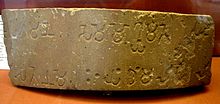
Fragment of the 6th Pillar Edict of Aoka (238 BC), in Brhm, sandstone. British Museum.

Great Stupa (3rd century BCE), Sanchi, India.
The Mauryan Emperor Aoka (273-232 BC) converted to Buddhism after his bloody conquest of the territory of Kalinga (modern Odisha) in eastern India during the Kalinga War.
Regretting the horrors and misery brought about by the conflict, the
king magnanimously decided to renounce violence, to replace the misery
caused by war with respect and dignity for all humanity. He propagated
the faith by building stupas and pillars urging, amongst other things, respect of all animal life and enjoining people to follow the Dharma.
Perhaps the finest example of these is the Great Stupa in Sanchi, India
(near Bhopal). It was constructed in the 3rd century BC and later
enlarged. Its carved gates, called toranas,
are considered among the finest examples of Buddhist art in India. He
also built roads, hospitals, resthouses, universities and irrigation systems around the country. He treated his subjects as equals regardless of their religion, politics or caste.
This period marks the first spread of Buddhism beyond India to other
countries. According to the plates and pillars left by Aoka (the edicts of Aoka), emissaries were sent to various countries in order to spread Buddhism, as far south as Sri Lanka and as far west as the Greek kingdoms, in particular the neighboring Greco-Bactrian Kingdom, and possibly even farther to the Mediterranean.
3rd Buddhist council (c. 250 BC)
Main article: Third Buddhist Council
King Aoka convened the third Buddhist council around 250 BC at Pataliputra (today's Patna). It was held by the monk Moggaliputtatissa.
The objective of the council was to purify the Sagha, particularly
from non-Buddhist ascetics who had been attracted by the royal
patronage. Following the council, Buddhist missionaries were dispatched
throughout the known world.
Hellenistic world
Some of the edicts of Aoka
describe the efforts made by him to propagate the Buddhist faith
throughout the Hellenistic world, which at that time formed an
uninterrupted continuum from the borders of India to Greece. The edicts
indicate a clear understanding of the political organization in
Hellenistic territories: the names and locations of the main Greek
monarchs of the time are identified, and they are claimed as recipients
of Buddhist proselytism: Antiochus II Theos of the Seleucid Kingdom (261-246 BC), Ptolemy II Philadelphos of Egypt (285-247 BC), Antigonus Gonatas of Macedonia (276-239 BC), Magas (288-258 BCE) in Cyrenaica (modern Libya), and Alexander II (272-255 BC) in Epirus (modern Northwestern Greece).
Buddhist proselytism at the time of Emperor Aoka (260-218 BC), according to the edicts of Aoka.
- "The conquest by Dharma has been won here, on the borders, and even six hundred yojanas
(5,400-9,600 km) away, where the Greek king Antiochos rules, beyond
there where the four kings named Ptolemy, Antigonos, Magas and Alexander
rule, likewise in the south among the Cholas, the Pandyas, and as far as Tamraparni (Sri Lanka)." (edicts of Aoka, 13th Rock Edict, S. Dhammika).
Furthermore, according to Pli sources, some of Aoka's emissaries were Greek Buddhist monks, indicating close religious exchanges between the two cultures:
- "When the thera (elder) Moggaliputta, the illuminator of the
religion of the Conqueror (Aoka), had brought the (third) council to an
end (...) he sent forth theras, one here and one there: (...) and to
Aparantaka (the "Western countries" corresponding to Gujarat and Sindh) he sent the Greek (Yona) named Dhammarakkhita". (Mahavamsa XII).
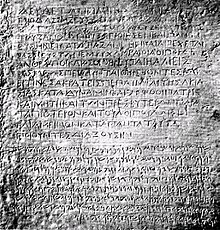
Bilingual inscription (Greek and Aramaic) by Emperor Aoka, from Kandahar. Kabul Museum (click image for full translation).
Aoka also issued edicts in the Greek language as well as in Aramaic.
One of them, found in Kandahar, advocates the adoption of "piety"
(using the Greek term eusebeia for Dharma) to the Greek community:
- "Ten years (of reign) having been completed, King Piodasses (Aoka) made known (the doctrine of) piety (Greek:, eusebeia) to men; and from this moment he has made men more pious, and everything thrives throughout the whole world."
- (Trans. from the Greek original by G.P. Carratelli[9])
It is not clear how much these interactions may have been influential, but some authors[citation needed] have commented that some level of syncretism
between Hellenist thought and Buddhism may have started in Hellenic
lands at that time. They have pointed to the presence of Buddhist
communities in the Hellenistic world around that period, in particular
in Alexandria (mentioned by Clement of Alexandria), and to the pre-Christian monastic order of the Therapeutae (possibly a deformation of the Pli word "Theravda"[10]), who may have "almost entirely drawn (its) inspiration from the teaching and practices of Buddhist asceticism"[11] and may even have been descendants of Aoka's emissaries to the West.[12] The philosopher Hegesias of Cyrene, from the city of Cyrene where Magas of Cyrene ruled, is sometimes thought to have been influenced by the teachings of Aoka's Buddhist missionaries.[13]
Buddhist gravestones from the Ptolemaic period have also been found in Alexandria, decorated with depictions of the Dharma wheel.[14]
The presence of Buddhists in Alexandria has even drawn the conclusion:
"It was later in this very place that some of the most active centers of
Christianity were established".[15]
In the 2nd century AD, the Christian dogmatist, Clement of Alexandria recognized Bactrian Buddhists (ramanas) and Indian gymnosophists for their influence on Greek thought:
- "Thus philosophy, a thing of the highest utility, flourished in
antiquity among the barbarians, shedding its light over the nations. And
afterwards it came to Greece. First in its ranks were the prophets of the Egyptians; and the Chaldeans among the Assyrians; and the Druids among the Gauls; and the ramanas among the Bactrians (" '"); and the philosophers of the Celts; and the Magi of the Persians, who foretold the Saviour's birth, and came into the land of Judea
guided by a star. The Indian gymnosophists are also in the number, and
the other barbarian philosophers. And of these there are two classes,
some of them called ramanas (""), and others Brahmins ("'")." Clement of Alexandria "The Stromata, or Miscellanies" Book I, Chapter XV[16]
Expansion to Sri Lanka and Burma
Further information: Buddhism in Sri Lanka and Buddhism in Burma
Sri Lanka was proselytized by Aoka's son Mahinda
and six companions during the 2nd century BC. They converted the King
Devanampiya Tissa and many of the nobility. In addition, Aoka's
daughter, Saghamitta also established the bhikkhun (order for nuns) in
Sri Lanka, also bringing with her a sapling of the sacred bodhi tree
that was subsequently planted in Anuradhapura. This is when the Mahvihra monastery, a center of Sinhalese orthodoxy, was built. The Pli canon
was written down in Sri Lanka during the reign of king Vattagamani
(29-17 BC), and the Theravda tradition flourished there. Later some
great commentators worked there, such as Buddhaghoa
(4th-5th century) and Dhammapla (5th-6th century), and they systemised
the traditional commentaries that had been handed down. Although
Mahyna Buddhism gained some influence in Sri Lanka at that time, the
Theravda ultimately prevailed and Sri Lanka turned out to be the last
stronghold of it. From there it would expand again to South-East Asia
from the 11th century.
In the areas east of the Indian subcontinent (modern Burma and Thailand), Indian culture strongly influenced the Mons. The Mons are said to have been converted to Buddhism from the 3rd century BC under the proselytizing of the Indian Emperor Aoka, before the fission between Mahyna and Hinayna Buddhism. Early Mon[citation needed] Buddhist temples, such as Peikthano in central Burma, have been dated to between the 1st and the 5th century CE.
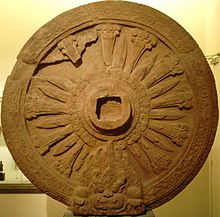
Mons Wheel of the Law (Dharmachakra), art of Dvaravati, c. 8th century.
The Buddhist art of the Mons was especially influenced by the Indian art of the Gupta
and post-Gupta periods, and their mannerist style spread widely in
South-East Asia following the expansion of the Mon kingdom between the
5th and 8th centuries. The Theravda faith expanded in the northern
parts of Southeast Asia under Mon influence, until it was progressively
displaced by Mahyna Buddhism from around the 6th century AD.
According to the Aokvadna (2nd century AD), Aoka sent a missionary to the north, through the Himalayas, to Khotan in the Tarim Basin, then the land of the Tocharians, speakers of an Indo-European language.
Rise of the Sunga (2nd-1st century BCE)
Further information: Sunga Empire
See also: Pusyamitra Sunga and Decline of Buddhism in India
The Sunga dynasty (185-73 BCE) was established in 185 BCE, about 50 years after Aoka's death. After assassinating King Brhadrata (last of the Mauryan rulers), military commander-in-chief Pusyamitra Sunga took the throne. Buddhist religious scriptures such as the Aokvadna allege that Pusyamitra (an orthodox Brahmin)
was hostile towards Buddhists and persecuted the Buddhist faith.
Buddhists wrote that he "destroyed hundreds of monasteries and killed
hundreds of thousands of innocent Monks":[17] 840,000 Buddhist stupas which had been built by Aoka were destroyed, and 100 gold coins were offered for the head of each Buddhist monk.[18] In addition, Buddhist sources allege that a large number of Buddhist monasteries (vihras) were converted to Hindu temples, in places like, but not limited to, Nalanda, Bodhgaya, Sarnath, and Mathura, among many others.
Modern historians, however, dispute this view in the light of
literary and archaeological evidence. They opine that following Aoka's
sponsorship of Buddhism, it is possible that Buddhist institutions fell
on harder times under the Sungas, but no evidence of active persecution
has been noted. Etienne Lamotte observes: "To judge from the documents, Pushyamitra must be acquitted through lack of proof."[19] Another eminent historian, Romila Thapar
points to archaeological evidence that "suggests the contrary" to the
claim that "Pusyamitra was a fanatical anti-Buddhist" and that he "never
actually destroyed 840,000 stupas as claimed by Buddhist works, if
any". Thapar stresses that Buddhist accounts are probably hyperbolic
renditions of Pusyamitra's attack of the Mauryas, and merely reflect the
desperate frustration of the Buddhist religious figures in the face of
the possibly irreversible decline in the importance of their religion
under the Sungas.[20]
During the period, Buddhist monks deserted the Ganges valley, following either the northern road (uttarapatha) or the southern road (dakinapatha).[21] Conversely, Buddhist artistic creation stopped in the old Magadha area, to reposition itself either in the northwest area of Gandhra and Mathura or in the southeast around Amaravati. Some artistic activity also occurred in central India, as in Bhrhut, to which the Sungas may or may not have contributed.
Greco-Buddhist interaction (2nd century BCE-1st century CE)
|
|
This section does not cite any references or sources. Please help improve this section by adding citations to reliable sources. Unsourced material may be challenged and removed. (October 2008) |
Main article: Greco-Buddhism
See also: Greco-Buddhist art and Buddhism and the Roman world

Silver drachm of Menander I (reigned c. 160-135 BCE).
Obv: Greek legend, BASILEOS SOTEROS MENANDROY lit. "of the Saviour King Menander".
In Bactria
(today's northern Afghanistan), the areas west of the Indian
subcontinent, neighboring Greek kingdoms had been in place since the
time of the conquests of Alexander the Great around 326 BCE: first the Seleucids from around 323 BCE, then the Greco-Bactrian Kingdom from around 250 BCE.
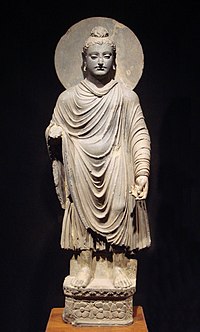
A Greco-Buddhist statue, one of the first representations of the Buddha, 1st-2nd century CE, Gandhara.
The Greco-Bactrian king Demetrius I invaded India in 180 BCE as far as Ptaliputra, establishing an Indo-Greek kingdom
that was to last in parts of northern India until the end of the 1st
century BCE. Buddhism flourished under the Indo-Greek kings, and it has
been suggested that their invasion of India was intended to show their
support for the Mauryan empire and to protect the Buddhist faith from the alleged religious persecutions of the Sungas (185-73 BCE).
One of the most famous Indo-Greek kings is Menander
(reigned c. 160-135 BCE). He apparently converted to Buddhism and is
presented in the Mahyna tradition as one of the great benefactors of
the faith, on a par with king Aoka or the later Kushan king Kanika.
Menander's coins bear the mention of the "saviour king" in Greek; some
bear designs of the eight-spoked wheel. Direct cultural exchange is also
suggested by the dialogue of the Milinda Paha between Menander and the monk Ngasena
around 160 BCE. Upon his death, the honor of sharing his remains was
claimed by the cities under his rule, and they were enshrined in stupas, in a parallel with the historic Buddha.[22] Several of Menander's Indo-Greek successors inscribed "Follower of the Dharma," in the Kharoh script, on their coins, and depicted themselves or their divinities forming the vitarka mudr.

A coin of Menander I with an eight-spoked wheel and a palm of victory on the reverse (British Museum).
The interaction between Greek and Buddhist cultures may have had some
influence on the evolution of Mahyna, as the faith developed its
sophisticated philosophical approach and a man-god treatment of the
Buddha somewhat reminiscent of Hellenic gods. It is also around that
time that the first anthropomorphic representations of the Buddha are found, often in realistic Greco-Buddhist
style: "One might regard the classical influence as including the
general idea of representing a man-god in this purely human form, which
was of course well familiar in the West, and it is very likely that the
example of westerner's treatment of their gods was indeed an important
factor in the innovation."[23]
Central Asian expansion
A Buddhist gold coin from India was found in northern Afghanistan at the archaeological site of Tillia Tepe, and dated to the 1st century CE. On the reverse, it depicts a lion in the moving position with a nandipada in front of it, with the Kharoh legend "Sih[o] vigatabhay[o]" ("The lion who dispelled fear").
The Mahayana Buddhists symbolized Buddha with animals such as a lion,
an elephant, a horse or a bull. A pair of feet was also used. The
symbol called by the archaeologists and historians as "nandipada" is
actually a composite symbol. The symbol at the top symbolizes 'the
Middle Path,' the Buddha Dhamma. The circle with a centre symbolizes
chakra. Thus, the composite symbol symbolizes 'Dhamma Chakra.' Thus, the
symbols on the reverse of the coin jointly symbolize Buddha rolling the
Dhamma Chakra.In the 'Lion Capital' of Saranath,India, Buddha rolling
the Dhamma Chakra is depicted on the wall of the cylinder with lion,
elephant, horse and bull rolling the Dhamma Chakras. Buddhism Is One Of
The Most Practiced Religions In The World Today. On the obverse, an
almost naked man only wearing an Hellenistic chlamys and wearing a head-dress rolls a Buddhist wheel.
The legend in Kharoh reads "Dharmacakrapravata[ko]" ("The one who
turned the Wheel of the Law"). It has been suggested that this may be an
early representation of the Buddha.[24]
The head dress symbolizes 'the Middle Path.' Thus, the man with the
head dress is a person who adheres to the Middle Path. In one of the
Indus Valley seals also, we find similar head dress worn by 9 women!
Thus, on both sides of the coin, we find Buddha rolling the Dhamma chakra.
As no scientific study on literary and physical symbolization of
Buddha and Buddhism was conducted by the archaeologists and historians,
imaginary and false interpretations were only given on coins, seals,
Brahmi and other inscriptions and other archaeological finds.
Rise of Mahyna (1st century BCE-2nd century CE)
|
|
This section does not cite any references or sources. Please help improve this section by adding citations to reliable sources. Unsourced material may be challenged and removed. (May 2009) |
Further information: Mahayana
Coin of the Kushan emperor Kanishka, with the Buddha on the reverse, and his name "BODDO" in Greek script, minted circa 120 CE.
The rise of Mahyna Buddhism from the 1st century BCE was accompanied by complex political changes in northwestern India. The Indo-Greek kingdoms were gradually overwhelmed, and their culture assimilated by the Indo-Scythians, and then the Yuezhi, who founded the Kushan Empire from around 12 BCE.
The new form of Buddhism was characterized by the idea that all
beings have a Buddha-nature and should aspire to Buddhahood, and by a
syncretism due to the various cultural influences within northwestern
India and the Kushan Empire.
In the Kanishka coin, the composite symbol placed by the side of the
enlightened Buddha symbolizes 'the Four Noble Truths that emphasize the
Middle Path, the Buddha Dhamma.'
The Two Fourth Councils
|
|
This section does not cite any references or sources. Please help improve this section by adding citations to reliable sources. Unsourced material may be challenged and removed. (May 2009) |
Main article: The Fourth Buddhist Councils
The Fourth Council is said to have been convened in the reign of the Kushan emperor Kanika
around 100 CE at Jalandhar or in Kashmir. Theravda Buddhism had its
own Fourth Council in Sri Lanka about 200 years earlier in which the
Pli canon was written down in toto for the first time. Therefore there were two Fourth Councils: one in Sri Lanka (Theravda), and one in Kashmir (Sarvstivdin).

Extent of Buddhism and trade routes in the 1st century CE.
It is said that for the Fourth Council of Kashmir, Kanika gathered 500 monks headed by Vasumitra, partly, it seems, to compile extensive commentaries on the Abhidharma,
although it is possible that some editorial work was carried out upon
the existing canon itself. Allegedly during the council there were
altogether three hundred thousand verses and over nine million
statements compiled, and it took twelve years to complete. The main
fruit of this council was the compilation of the vast commentary known
as the Mah-Vibhsh ("Great Exegesis"), an extensive compendium and
reference work on a portion of the Sarvstivdin Abhidharma.
Scholars believe that it was also around this time that a significant
change was made in the language of the Sarvstivdin canon, by
converting an earlier Prakrit version into Sanskrit.
Although this change was probably effected without significant loss of
integrity to the canon, this event was of particular significance since
Sanskrit was the sacred language of Brahmanism
in India, and was also being used by other thinkers, regardless of
their specific religious or philosophical allegiance, thus enabling a
far wider audience to gain access to Buddhist ideas and practices. For
this reason there was a growing tendency among Buddhist scholars in
India thereafter to write their commentaries and treatises in Sanskrit.
Many of the early schools, however, such as Theravda, never switched to
Sanskrit, partly because Buddha explicitly forbade translation of his
discourses into what was an elitist religious language (as Latin
was in medieval Europe). He wanted his monks to use a local language
instead - a language which could be understood by all. Over time,
however, the language of the Theravdin scriptures (Pli) became a scholarly or elitist language as well, exactly opposite to what the Buddha had explicitly commanded.
Mahyna expansion (1st century CE-10th century CE)
Further information: Mahayana

Expansion of Mahyna Buddhism between the 1st and 10th centuries CE.
From that point on, and in the space of a few centuries, Mahyna was to flourish and spread in the East from India to South-East Asia, and towards the north to Central Asia, China, Korea, and finally to Japan in 538 CE and Tibet in the 7th century.
India
|
|
This section does not cite any references or sources. Please help improve this section by adding citations to reliable sources. Unsourced material may be challenged and removed. (May 2009) |
Further information: History of Buddhism in India
After the end of the Kushans, Buddhism flourished in India during the dynasty of the Guptas (4th-6th century). Mahyna centers of learning were established, especially at Nland
in north-eastern India, which was to become the largest and most
influential Buddhist university for many centuries, with famous teachers
such as Ngrjuna. The influence of the Gupta style of Buddhist art spread along with the faith from south-east Asia to China.

Buddha and Bodhisattvas, 11th century, Pla empire.
Indian Buddhism had weakened in the 6th century following the White Hun invasions and Mihirkulas persecution.
Xuanzang reported in his travels across India during the 7th century, of Buddhism being popular in Andhra, Dhanyakataka, and Dravida, which area today roughly corresponds to the modern day Indian states of Andhra Pradesh and Tamil Nadu.[25] While reporting many deserted stupas in the area around modern day Nepal and the persecution of Buddhists by Ssanka in the Kingdom of Gouda in modern day West Bengal, Xuanzang complimented the patronage of Haravardana during the same period. After the Haravardana kingdom, the rise of many small kingdoms that led to the rise of the Rajputs
across the gangetic plains and marked the end of Buddhist ruling clans
along with a sharp decline in royal patronage until a revival under the Pla empire in the Bengal region. Here Mahyna Buddhism flourished and spread to Tibet, Bhutan and Sikkim between the 7th and the 12th centuries before the Plas collapsed under the assault of the Hindu Sena dynasty. The Plas created many temples and a distinctive school of Buddhist art. Xuanzang noted in his travels that in various regions Buddhism was giving way to Jainism and Hinduism.[26]
By the 10th century Buddhism had experienced a sharp decline beyond the
Pla realms in Bengal under a resurgent Hinduism and the incorporation
in Vaishnavite Hinduism of Buddha as the 9th incarnation of Vishnu.[27]
A milestone in the decline of Indian Buddhism in the North occurred in 1193 when Turkic Islamic raiders under Muhammad Khilji burnt Nland. By the end of the 12th century, following the Islamic conquest of the Buddhist strongholds in Bihar
and the loss of political support coupled with social pressures, the
practice of Buddhism retreated to the Himalayan foothills in the North
and Sri Lanka in the south. Additionally, the influence of Buddhism also waned due to Hinduism's revival movements such as Advaita, the rise of the bhakti movement and the missionary work of Sufis.
See also: Indian Buddhism and Decline of Buddhism in India
Central and Northern Asia
|
|
This section does not cite any references or sources. Please help improve this section by adding citations to reliable sources. Unsourced material may be challenged and removed. (May 2009) |
Further information: Silk Road transmission of Buddhism
Central Asia
Central Asia had been influenced by Buddhism probably almost since the time of the Buddha. According to a legend preserved in Pli,
the language of the Theravdin canon, two merchant brothers from
Bactria named Tapassu and Bhallika visited the Buddha and became his
disciples. They then returned to Bactria and built temples to the
Buddha.[28]
Central Asia long played the role of a meeting place between China, India and Persia. During the 2nd century BCE, the expansion of the Former Han to the west brought them into contact with the Hellenistic civilizations of Asia, especially the Greco-Bactrian Kingdoms. Thereafter, the expansion of Buddhism to the north led to the formation of Buddhist communities and even Buddhist kingdoms in the oases of Central Asia. Some Silk Road
cities consisted almost entirely of Buddhist stupas and monasteries,
and it seems that one of their main objectives was to welcome and
service travelers between east and west.
The Theravdin traditions first spread among the Iranian tribes before combining with the Mahyna forms during the 2nd and 3rd centuries BCE to cover modern-day Pakistan, Kashmir, Afghanistan, eastern and coastal Iran, Uzbekistan, Turkmenistan and Tajikistan. These were the ancient states of Gandhra, Bactria, Parthia and Sogdia from where it spread to China. Among the first of these states to come under the influence of Buddhism was Bactria as early as the 3rd century BCE (see Greco-Buddhism). It was not, however, the exclusive faith of this region. There were also Zoroastrians, Hindus, Nestorian Christians, Jews, Manichaeans, and followers of shamanism, Tengrism, and other indigenous, nonorganized systems of belief.
Various Nikya
schools persisted in Central Asia and China until around the 7th
century CE. Mahyna started to become dominant during the period, but
since the faith had not developed a Nikaya approach, Sarvstivdins and Dharmaguptakas remained the Vinayas of choice in Central Asian monasteries.
Various Buddhist kingdoms rose and prospered in both the Central
Asian region and downwards into the Indian sub-continent such as the Kushan Empire prior to the White Hun invasion in the 5th century where under the King Mihirkula they were heavily persecuted.
Buddhism in Central Asia started to decline with the expansion of Islam and the destruction of many stupas in war from the 7th century. The Muslims accorded them the status of dhimmis as "people of the Book", such as Christianity or Judaism and Al-Biruni wrote of Buddha as prophet "burxan".
Buddhism saw a surge during the reign of Mongols following the invasion of Genghis Khan and the establishment of the Il Khanate and the Chagatai Khanate who brought their Buddhist influence with them during the 13th century; however, within 100 years the Mongols who remained in that region would convert to Islam and spread Islam across all the regions of central Asia. Only the eastern Mongols and the Mongols of the Yuan dynasty would keep Vajrayna Buddhism.
See also: Silk Road, Silk Road transmission of Buddhism, and Buddhism
Parthia
See also: Parthia
Buddhism expanded westward into Arsacid Parthia, at least to the area of Merv, in ancient Margiana, today's territory of Turkmenistan. Soviet archeological teams have excavated in Giaur Kala near Merv a Buddhist chapel, a gigantic Buddha statue and a monastery.
Parthians were directly involved in the propagation of Buddhism: An Shigao (c. 148 CE), a Parthian prince, went to China, and is the first known translator of Buddhist scriptures into Chinese.
Tarim Basin

Blue-eyed Central Asian and East-Asian Buddhist monks, Bezeklik, Eastern Tarim Basin, China, 9th and 10th centuries.
The eastern part of central Asia (Chinese Turkestan, Tarim Basin, Xinjiang)
has revealed extremely rich Buddhist works of art (wall paintings and
reliefs in numerous caves, portable paintings on canvas, sculpture,
ritual objects), displaying multiple influences from Indian and
Hellenistic cultures. Serindian art is highly reminiscent of the Gandhran style, and scriptures in the Gandhri script Kharoh have been found.
Central Asians seem to have played a key role in the transmission of
Buddhism to the East. The first translators of Buddhists scriptures into
Chinese were Parthian (Ch: Anxi) like An Shigao (c. 148 CE) or An Hsuan, Kushan of Yuezhi ethnicity like Lokaksema (c. 178 CE), Zhi Qian and Zhi Yao or Sogdians
(Ch: SuTe/) like Kang Sengkai. Thirty-seven early translators of
Buddhist texts are known, and the majority of them have been identified
as Central Asians.
Central Asian and East Asian Buddhist monks appear to have maintained
strong exchanges until around the 10th century, as shown by frescoes
from the Tarim Basin.
These influences were rapidly absorbed, however, by the vigorous
Chinese culture, and a strongly Chinese particularism develops from that
point.
See also: Dunhuang and Kingdom of Khotan
China
|
|
This section does not cite any references or sources. Please help improve this section by adding citations to reliable sources. Unsourced material may be challenged and removed. (May 2009) |
Main article: Buddhism in China
See also: Tang Dynasty art and Chinese Buddhist cuisine
According to traditional accounts, Buddhism was introduced in China during the Han dynasty
(206 BCE-220 CE) after an emperor dreamed of a flying golden man
thought to be the Buddha. Although the archaeological record confirms
that Buddhism was introduced sometime during the Han dynasty, it did not
flourish in China until the Six Dynasties period (220-589 CE).[29]
The year 67 CE saw Buddhism's official introduction to China with the coming of the two monks Moton and Chufarlan. In 68 CE, under imperial patronage, they established the White Horse Temple (), which still exists today, close to the imperial capital at Luoyang. By the end of the 2nd century, a prosperous community had settled at Pengcheng (modern Xuzhou, Jiangsu).
The first known Mahyna scriptural texts are translations into
Chinese by the Kushan monk Lokakema in Luoyang, between 178 and 189 CE.
Some of the earliest known Buddhist artifacts found in China are small
statues on "money trees", dated c. 200 CE, in typical Gandhran drawing
style: "That the imported images accompanying the newly arrived doctrine
came from Gandhra is strongly suggested by such early Gandhra
characteristics on this "money tree" Buddha as the high unia, vertical
arrangement of the hair, moustache, symmetrically looped robe and
parallel incisions for the folds of the arms."[30]

Maitreya Buddha, Northern Wei, 443 CE.
In the period between 460-525 AD during the Northern Wei dynasty, the Chinese constructed Yungang Grottoes,
it's an outstanding example of the Chinese stone carvings from the 5th
and 6th centuries. All together the site is composed of 252 grottoes
with more than 51,000 Buddha statues and statuettes.
Another famous Buddhism Grottoes is Longmen Grottoes
which started with the Northern Wei Dynasty in 493 AD. There are as
many as 100,000 statues within the 1,400 caves, ranging from an 1 inch
(25 mm) to 57 feet (17 m) in height. The area also contains nearly 2,500
stelae and inscriptions, whence the name "Forest of Ancient Stelae", as
well as over sixty Buddhist pagodas.
Buddhism flourished during the beginning of the Tang Dynasty
(618-907). The dynasty was initially characterized by a strong openness
to foreign influences and renewed exchanges with Indian culture due to
the numerous travels of Chinese Buddhist monks to India from the 4th to
the 11th centuries. The Tang capital of Chang'an (today's Xi'an) became an important center for Buddhist thought. From there Buddhism spread to Korea, and Japanese embassies of Kentoshi helped gain footholds in Japan.
However, foreign influences came to be negatively perceived towards
the end of the Tang Dynasty. In the year 845, the Tang emperor Wuzong outlawed all "foreign" religions including Christian Nestorianism, Zoroastrianism, and Buddhism in order to support the indigenous Taoism.
Throughout his territory, he confiscated Buddhist possessions,
destroyed monasteries and temples, and executed Buddhist monks, ending
Buddhism's cultural and intellectual dominance.
However, about a hundred years after the Great Anti-Buddhist Persecution, Buddhism revived during the Song Dynasty (1127-1279).
Pure Land and Chan Buddhism, however, continued to prosper for some centuries, the latter giving rise to Japanese Zen. In China, Chan flourished particularly under the Song Dynasty (1127-1279), when its monasteries were great centers of culture and learning.
In the last two thousand years, the Buddhist have build The Four Sacred Mountains of Buddhism, they are Mount Wutai, Mount Emei, Mount Jiuhua, Mount Putuo.
Today, China boasts one of the richest collections of Buddhist arts and heritages in the world. UNESCO World Heritage Sites such as the Mogao Caves near Dunhuang in Gansu province, the Longmen Grottoes near Luoyang in Henan province, the Yungang Grottoes near Datong in Shanxi province, and the Dazu Rock Carvings near Chongqing are among the most important and renowned Buddhist sculptural sites. The Leshan Giant Buddha, carved out of a hillside in the 8th century during the Tang Dynasty and looking down on the confluence of three rivers, is still the largest stone Buddha statue in the world.
Korea
Main article: Buddhism in Korea
Buddhism was introduced around 372 CE, when Chinese ambassadors visited the Korean kingdom of Goguryeo, bringing scriptures and images. Buddhism prospered in Korea - in particular Seon (Zen) Buddhism from the 7th century onward. However, with the beginning of the Confucian Yi Dynasty of the Joseon period
in 1392, a strong discrimination took place against Buddhism until it
was almost completely eradicated, except for a remaining Seon movement.
Japan

Tile with seated Buddha, Nara Prefecture, Asuka period, 7th century. Tokyo National Museum.
Main article: Buddhism in Japan
See also: Japanese Art and Zen
The Buddhism of Japan was introduced from Three Kingdoms of Korea in the 6th century. The Chinese priest Ganjin offered the system of Vinaya to the Buddhism of Japan in 754. As a result, the Buddhism of Japan has developed rapidly. Saich and Kkai succeeded to a legitimate Buddhism from China in the 9th century.
Being geographically at the end of the Silk Road,
Japan was able to preserve many aspects of Buddhism at the very time it
was disappearing in India, and being suppressed in Central Asia and
China.
From 710 CE numerous temples and monasteries were built in the capital city of Nara, such as the five-story pagoda and Golden Hall of the Hry-ji, or the Kfuku-ji
temple. Countless paintings and sculptures were made, often under
governmental sponsorship. The creations of Japanese Buddhist art were
especially rich between the 8th and 13th centuries during the periods of
Nara, Heian and Kamakura.
From the 12th and 13th centuries, a further development was Zen art, following the introduction of the faith by Dogen and Eisai upon their return from China. Zen art is mainly characterized by original paintings (such as ink wash and the Enso) and poetry (especially haikus),
striving to express the true essence of the world through
impressionistic and unadorned "non-dualistic" representations. The
search for enlightenment "in the moment" also led to the development of
other important derivative arts such as the Chanoyu tea ceremony or the Ikebana
art of flower arrangement. This evolution went as far as considering
almost any human activity as an art with a strong spiritual and
aesthetic content, first and foremost in those activities related to
combat techniques (martial arts).
Buddhism remains very active in Japan to this day. Around 80,000 Buddhist temples are preserved and regularly restored.
Tibet
See also: Tibetan Buddhism and Tibetan art
Buddhism arrived late in Tibet, during the 7th century CE. The form that predominated, via the south of Tibet, was a blend of mahyna and vajrayna from the universities of the Pla empire of north India.[31] Sarvstivdin influence came from the south west (Kashmir)[32] and the north west (Khotan).[33] Although these practitioners did not succeed in maintaining a presence in Tibet, their texts found their way into the Tibetan Buddhist canon, providing the Tibetans with almost all of their primary sources about the Foundation Vehicle. A subsect of this school, Mlasarvstivda was the source of the Tibetan Vinaya.[34]
Chan Buddhism was introduced via east Tibet from China and left its
impression, but was rendered of lesser importance by early political
events.[35]
From the outset Buddhism was opposed by the native shamanistic Bon
religion, which had the support of the aristocracy, but with royal
patronage it thrived to a peak under King Rlpachn (817-836).
Terminology in translation was standardised around 825, enabling a
translation methodology that was highly literal. Despite a reversal in
Buddhist influence which began under King Langdarma (836-842), the
following centuries saw a colossal effort in collecting available Indian
sources, many of which are now extant only in Tibetan translation.
Tibetan Buddhism exerted a strong influence from the 11th century CE among the peoples of Central Asia, especially in Mongolia and Manchuria. It was adopted as an official state religion by the Mongol Yuan dynasty and the Manchu Qing dynasty that ruled China.
Southeast Asia
Further information: Indianized kingdom

Statue of the Bodhisattva Lokesvara, Cambodia, 12th century.

Cambodian Buddha, 14th century.
During the 1st century CE, the trade on the overland Silk Road tended to be restricted by the rise in the Middle-East of the Parthian empire, an unvanquished enemy of Rome,
just as Romans were becoming extremely wealthy and their demand for
Asian luxury was rising. This demand revived the sea connections between
the Mediterranean and China, with India as the intermediary of choice.
From that time, through trade connection, commercial settlements, and
even political interventions, India started to strongly influence Southeast Asian countries (excluding Vietnam). Trade routes linked India with southern Burma, central and southern Siam, lower Cambodia and Champa, and numerous urbanized coastal settlements were established there.
For more than a thousand years, Indian influence was therefore the
major factor that brought a certain level of cultural unity to the
various countries of the region. The Pli and Sanskrit languages and the Indian script, together with Theravda and Mahyna Buddhism, Brahmanism, and Hinduism, were transmitted from direct contact and through sacred texts and Indian literature such as the Rmyaa and the Mahbhrata.
From the 5th to the 13th centuries, South-East Asia had very powerful
empires and became extremely active in Buddhist architectural and
artistic creation. The main Buddhist influence now came directly by sea
from the Indian subcontinent, so that these empires essentially followed
the Mahyna faith. The Sri Vijaya Empire to the south and the Khmer Empire to the north competed for influence, and their art expressed the rich Mahyna pantheon of the Bodhisattvas.

The graceful golden statue of Avalokitevara in Malayu-Srivijayan style, Jambi, Indonesia.
Srivijayan Empire (7th-13th century)
Further information: Srivijaya
Srivijaya, a maritime empire centered at Palembang on the island of Sumatra in Indonesia, adopted Mahyna and Vajrayna Buddhism under a line of rulers named the Sailendras. Yijing described Palembang as a great centre of Buddhist learning where the emperor supported over a thousand monks at his court. Yijing
also testified to the importance of Buddhism as early as the year 671
and advised future Chinese pilgrims to spend a year or two in Palembang.[36] Atia studied there before travelling to Tibet as a missionary.
As Srivijaya expanded their thalassocracy,
Buddhism thrived amongst its people. However, many did not practice
pure Buddhism but a new syncretism form of Buddhism that incorporated
several different religions such as Hinduism and other indigenous
traditions.[37]
Srivijaya spread Buddhist art during its expansion in Southeast Asia. Numerous statues of Bodhisattvas
from this period are characterized by a very strong refinement and
technical sophistication, and are found throughout the region. Extremely
rich architectural remains are visible at the temple of Borobudur
the largest Buddhist structure in the world, built from around 780 CE
in Java, which has 505 images of the seated Buddha. Srivijaya declined
due to conflicts with the Chola rulers of India, before being destabilized by the Islamic expansion from the 13th century.
Khmer Empire (9th-13th centuries)
Further information: Khmer Empire
Later, from the 9th to the 13th centuries, the Mahyna Buddhist and Hindu Khmer Empire
dominated much of the South-East Asian peninsula. Under the Khmer, more
than 900 temples were built in Cambodia and in neighboring Thailand. Angkor
was at the center of this development, with a temple complex and urban
organization able to support around one million urban dwellers. One of
the greatest Khmer kings, Jayavarman VII (1181-1219), built large Mahyna Buddhist structures at Bayon and Angkor Thom.
Vietnam
Main article: Buddhism in Vietnam
Buddhism in Vietnam as practiced by the Vietnamese is mainly of
Mahyna tradition. Buddhism came from Vietnam as early as the 2nd
century CE through the North from Central Asia via India. Vietnamese
Buddhism is very similar to Chinese buddhism and to some extent reflects
the structure of Chinese Buddhism after the Song Dynasty. Vietnamese
Buddhism also has a symbiotic relationship with Taoism, Chinese
spirituality and the native Vietnamese religion.
Emergence of the Vajrayna (5th century)
Main article: Vajrayana
Vajrayna
Buddhism, also called tantric Buddhism, first emerged in eastern India
between the 5th and 7th centuries CE. It is sometimes considered a
sub-school of Mahyna and sometimes a third major "vehicle" (yna)
of Buddhism in its own right. The Vajrayna is an extension of Mahyna
Buddhism in that it does not offer new philosophical perspectives, but
rather introduces additional techniques (upaya, or 'skilful
means'), including the use of visualizations and other yogic practices.
Many of the practices of tantric Buddhism are common with Hindu tantricism: the usage of mantras, yoga and the burning of sacrificial offerings.
Early Vajrayna practitioners were forest-dwelling mahasiddhas
who lived on the margins of society, but by the 9th century Vajrayna
had won acceptance at major Mahyna monastic universities such as Nland and Vikramala.
Along with much of the rest of Indian Buddhism, the Vajrayna was
eclipsed in the wake of the late 12th-century Muslim invasions. It has
persisted in Tibet, where it was wholly transplanted from the 7th to
12th centuries, and on a limited basis in Japan as well where it evolved
into Shingon Buddhism.
See also: Tibetan Buddhism and Tibetan art
Theravda Renaissance (starting in the 11th century CE)
Further information: Theravada

Expansion of Theravda Buddhism from the 11th century CE.
From the 11th century, the destruction of Buddhism in the Indian
mainland by Islamic invasions led to the decline of the Mahyna faith
in South-East Asia. Continental routes through the Indian subcontinent
being compromised, direct sea routes developed from the Middle-East through Sri Lanka to China, leading to the adoption of the Theravda Buddhism of the Pli canon, introduced to the region around the 11th century CE from Sri Lanka.
King Anawrahta (1044-1078); the founder of the Pagan Empire,
unified the country and adopted the Theravdin Buddhist faith. This
initiated the creation of thousands of Buddhist temples at Pagan,
the capital, between the 11th and 13th centuries. Around 2,200 of them
are still standing. The power of the Burmese waned with the rise of the Thai, and with the seizure of the capital Pagan by the Mongols in 1287, but Theravda Buddhism remained the main Burmese faith to this day.
The Theravda faith was also adopted by the newly founded ethnic Thai kingdom of Sukhothai around 1260. Theravda Buddhism was further reinforced during the Ayutthaya period (14th-18th century), becoming an integral part of Thai society.
In the continental areas, Theravda Buddhism continued to expand into Laos and Cambodia
in the 13th century. From the 14th century, however, on the coastal
fringes and in the islands of south-east Asia, the influence of Islam proved stronger, expanding into Malaysia, Indonesia, and most of the islands as far as the southern Philippines.
Nevertheless, since Suharto's
rise to power in 1966, there has been a remarkable renaissance of
Buddhism in Indonesia. This is partly due to the requirements of
Suharto's New Order for the people of Indonesia to adopt one of the five official religions: Islam, Protestantism, Catholicism, Hinduism or Buddhism. Today it is estimated there are some 10 million Buddhists in Indonesia. A large part of them are people of Chinese ancestry.
Expansion of Buddhism to the West
Further information: Western Buddhism
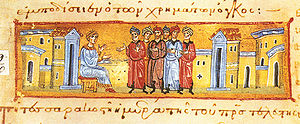
Saint Josaphat preaching Christianity. 12th-century Greek manuscript.
After the Classical encounters between Buddhism and the West recorded
in Greco-Buddhist art, information and legends about Buddhism seem to
have reached the West sporadically. An account of Buddha's life was
translated into Greek by John of Damascus, and widely circulated to Christians as the story of Barlaam and Josaphat. By the 14th century this story of Josaphat had become so popular that he was made a Catholic saint.
The next direct encounter between Europeans and Buddhism happened in Medieval times when the Franciscan friar William of Rubruck was sent on an embassy to the Mongol court of Mongke by the French king Saint Louis in 1253. The contact happened in Cailac (today's Qayaliq in Kazakhstan), and William originally thought they were wayward Christians (Foltz, "Religions of the Silk Road").
In the period after Hulagu, the Mongol Ilkhans increasingly adopted Buddhism. Numerous Buddhist temples dotted the landscape of Persia and Iraq, none of which survived the 14th century. The Buddhist element of the Il-Khanate died with Arghun.[38]
The Kalmyk Khanate was founded in the 17th century with Tibetan Buddhism as its main religion, following the earlier migration of the Oirats from Dzungaria through Central Asia to the steppe around the mouth of the Volga River. During the course of the 18th century, they were absorbed by the Russian Empire.[39] At the end of the Napoleonic wars, Kalmyk cavalry units in Russian service entered Paris.[40] Kalmykia is remarkable for being the only state in Europe where the dominant religion is Buddhism.
Interest in Buddhism increased during the colonial era, when Western
powers were in a position to witness the faith and its artistic
manifestations in detail. The opening of Japan
in 1853 created a considerable interest in the arts and culture of
Japan, and provided access to one of the most thriving Buddhist cultures
in the world.
Buddhism started to enjoy a strong interest from the general
population in the West following the turbulence of the 20th century. In
the wake of the 1959 Tibetan uprising, a Tibetan diaspora
has made Tibetan Buddhism in particular more widely accessible to the
rest of the world. It has since spread to many Western countries, where
the tradition has gained popularity. Among its prominent exponents is
the 14th Dalai Lama of Tibet. The number of its adherents is estimated to be between ten and twenty million.[41]

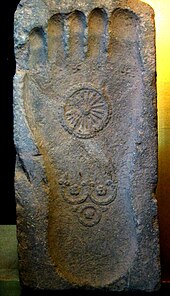

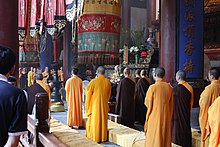 Buddhist monks performing a ceremony in Hangzhou, China
Buddhist monks performing a ceremony in Hangzhou, China


























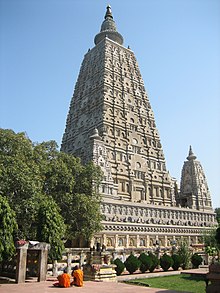
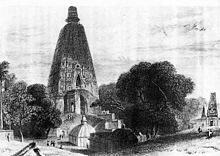


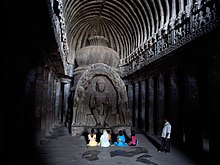
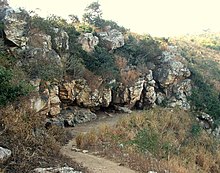







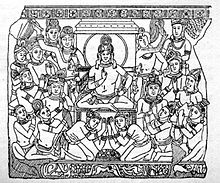








comment:
p_commentcount